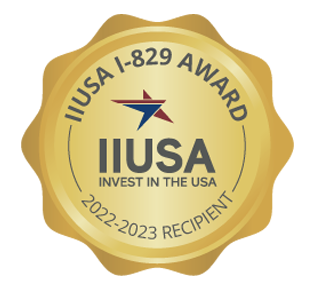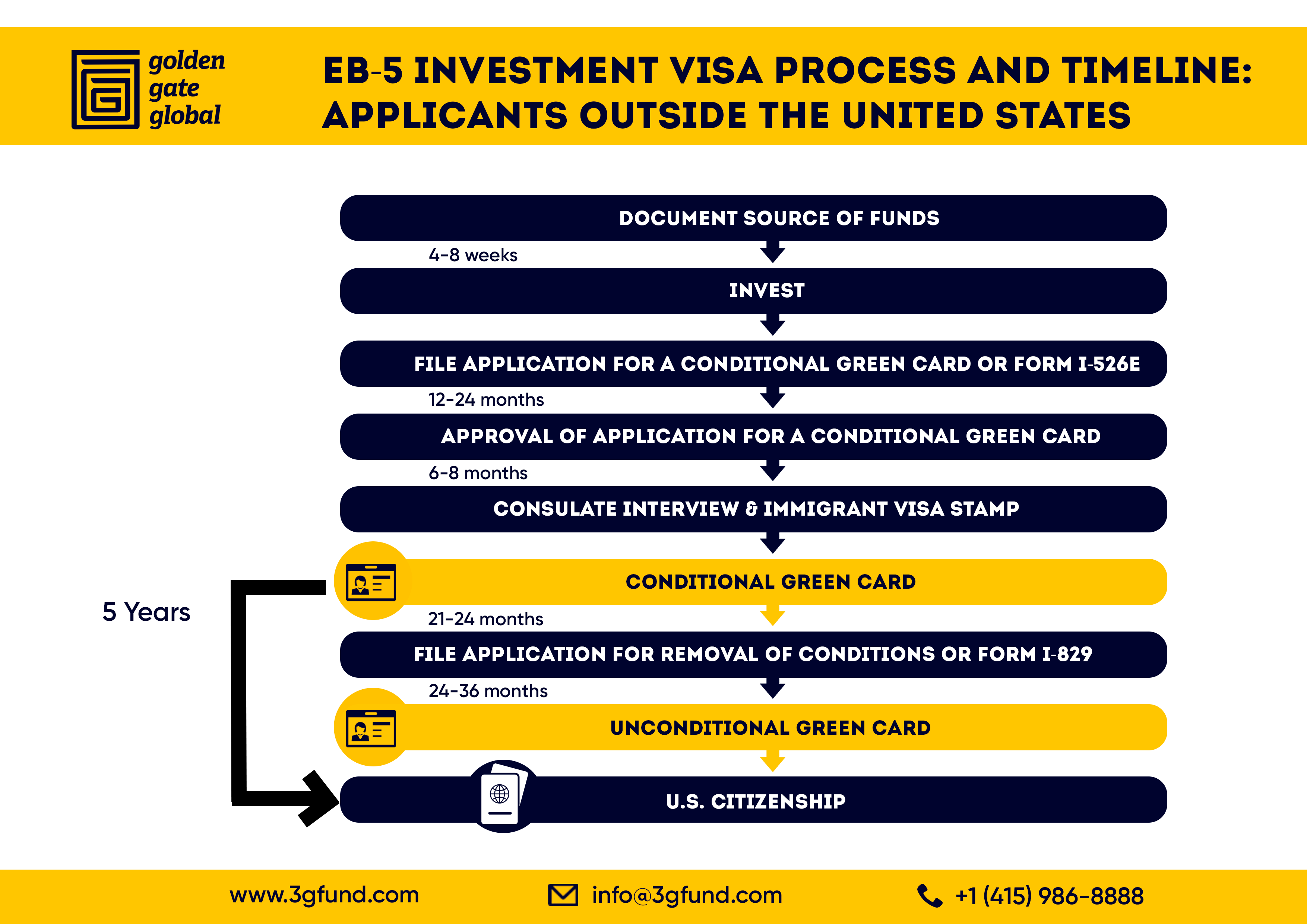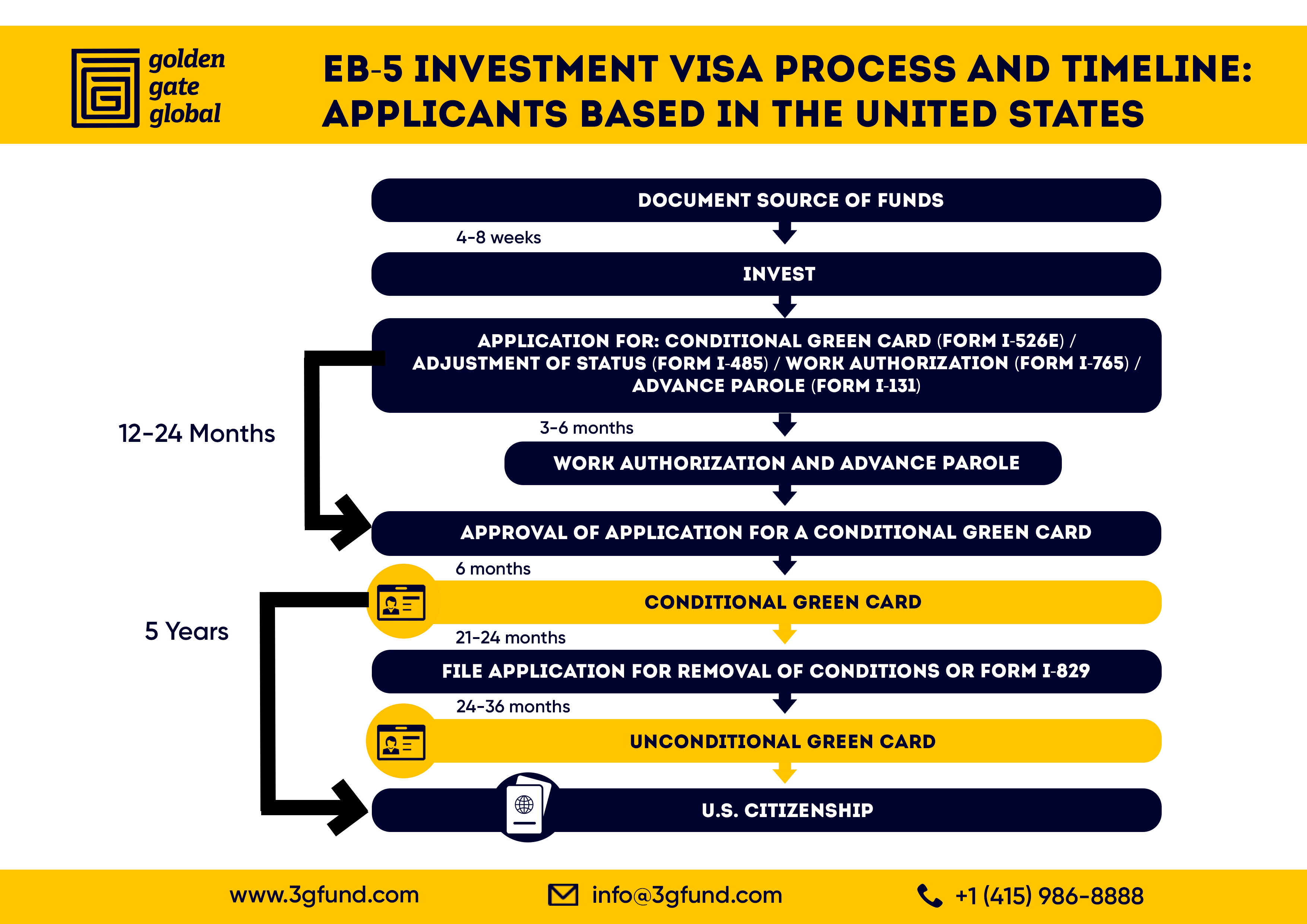What is the process and timeline for obtaining an EB5 Visa by investing in a Regional Center?
The EB-5 visa process is a multistage process. Based on the terms and conditions of the EB-5 Reform and Integrity Act of 2022 (RIA), the process of your EB-5 visa petition will vary on whether you reside in the US, or overseas at the time of your application.
1. Regional Center EB5 Visa process for investors who are residing outside the United States includes:
- Retaining an immigration attorney to document the source of funds
- Review and subscribe to the EB-5 project for investment
- Filing an application for a conditional green card (form I-526E)
- Review and subscribe to the EB-5 project for investment
- Preparing for the counselor interview
- Repayment of investment capital based on offering terms
- Filing an application for removal of conditions (Form I-829)
- Receipt of Unconditional Green Card
2. Regional Center EB5 Visa Process for applicants who are U.S.- based:
- Retaining an immigration attorney to document the source of funds
- Review and subscribe to the EB-5 project for investment Filing an application for a conditional green card (form I-562E)
- Filing an application for adjustment of status (form I-485)
- Filing an application for work authorization (form I-765)
- Receipt of work authorization
- Receipt of Conditional Green Card
- Repayment of investment capital based on offering terms
- Filing for Removal of Conditions
- Receipt of Unconditional Green Card
Importantly, the EB-5 program is not only about achieving your immigration goals, but also about the preservation of your capital.
EB-5 process for applicants residing outside the U.S.
1. Document the source of funds
An EB-5 investor must prove the legal nature of the funds they are investing in an EB-5 project. A U.S.-licensed immigration attorney can assist you to prepare all the documentation needed at this stage, and Golden Gate Global can refer you to immigration attorneys experienced in EB-5 applications. Certain applicants choose to source their funding from gifts from parents or relatives. The funds may originate from professional income, investment portfolio, sale of property, or a loan. Your immigration attorney will inform you of the specifics of your circumstances.
2. Review project documentation and make an eligible investment
An important step of your EB-5 process is to review the offering documents and upon satisfactory due diligence, subscribing to the EB-5 offering, making the investment and filing your I-526E petition. USCIS will review and adjudicate whether the proposed EB-5 project meets the requirements of immigration law when Golden Gate files a project approval petition, namely I-956F (Application for Approval of an Investment in a Commercial Enterprise). The minimum required investment is $800,000 for EB-5 projects that are located in certain designated areas (such as Targeted Employment Areas and Rural Areas) and $1,050,000 in non-qualified areas.
3. File an Immigrant Petition (I-526E form) and Receive a Conditional Green Card
After subscribing and investing, your attorney will file an application for a conditional green card. The processing times vary based on USCIS’ adjudication process, but based on prior cases, adjudication of I-526Es may take anywhere between 12 to 24 months upon filing the I-526E. Please refer to the USCIS website for current processing times for EB-5 visa categories and consult your immigration attorney to ensure estimated timelines meet your immigration goals.
4. Consulate Interview
Once the approval for form I-526E is received, the case gets transferred from USCIS to the National Visa Center, and in about 6 to 8 months (timeline for informational purposes, please refer to your immigration attorney and USCIS for actual time frames), you will be invited for a consular interview. The investor and the dependents who wish to receive the conditional green card are required to attend the interview.
The Regional Center team and immigration attorneys help you prepare for the interview and provide all necessary information, including data regarding the progress of the project and information on the use of EB-5 funds in the project and American job creation.
The examples of questions to expect at the interview.
What is the nature of the project, which includes the asset class?
What is the latest update on the project?
How were the funds sourced and invested in the project?
5. Entry to United States
Once you successfully appear for an interview, you will receive an immigrant visa stamp on your passport, and you have 6 months to enter the United States. The day you set foot in the United States, your conditional green card gets activated. The immigration officer at the port of entry will note down your details, and the green card will be sent via mail.
6. Repayment of Capital
According to the USCIS announcements and policy updates in Q4 2023/Q1 2024, EB-5 investors are now entitled to the repayment of their capital, provided their investment remains with the job-creating entity for a minimum of two years. This means an EB-5 project is positioned to return the invested capital within approximately 2 to 5 years from the time funds are released to the EB-5 project, typically as a construction loan. For detailed information on the recent modifications to EB-5 repayment schedules and the latest guidelines for the sustainment period applicable to both new and current investors, please click here.
7. File form I-829 – Removal Conditions
You are eligible to file for removal of conditions 21 months after you receive your conditional green card and before the expiration of 24 months. Your immigration attorney will file Form I-829, Petition by Investor to Remove Conditions on Permanent Resident Status, within this time frame.8. Receipt of Unconditional Green Card.
8. Receipt of Unconditional Green Card
Typically, it takes about 30 to 36 months (please refer to USCIS website for current processing times) to issue an unconditional green card after filing the I-829 petition. Therefore, USCIS extends the conditional green card by 48 months from the day you file your application for removal of conditions to ensure there is no gap in your status.
There is almost no difference between a conditional green card and an unconditional green card in terms of your obligations, rights, and responsibilities. Regardless of where you reside, whether inside or outside the United States, your investment amount and obligation to create ten American jobs remain the same.
EB-5 process for U.S.-Based applicants
The EB-5 application process is slightly different if you are already living, studying and/or workingin the United States on any type of visa. If you switch to an EB-5 visa from an employment-based visa, like H1B or L1, or from a visa for international students, like F-1, J-1, or M-1, or an entrepreneur visa like E2 visa, the steps below will be relevant to you.
1. Documenting the source of funds
An EB-5 investor must prove the legal nature of the funds they are investing in an EB-5 project. A U.S.-licensed immigration attorney can assist you to prepare all the documentation needed at this stage, and Golden Gate Global can refer you to immigration attorneys experienced in EB-5 applications. Certain applicants choose to source their funding from gifts from parents or relatives. The funds may originate from professional income, investment portfolio, sale of property, or a loan. Your immigration attorney will inform you of the specifics of your circumstances.
2. Review project documentation and make an eligible investment
An important step of your EB-5 process is to review the offering documents and upon satisfactory due diligence, subscribing to the EB-5 offering, making the investment and filing your I-526E petition. USCIS will review and adjudicate whether the proposed EB-5 project meets the requirements of immigration law when Golden Gate files a project approval petition, namely I-956F (Application for Approval of an Investment in a Commercial Enterprise). The minimum required investment is $800,000 for EB-5 projects that are located in certain designated areas (such as Targeted Employment Areas and Rural Areas) and $1,050,000 in non-qualified areas.
3. Concurrent filing for a Conditional Green Card (Form I-526E), Adjustment of Status (Form I-485), and Work Authorization (Form I-765)
On March 15, 2022, the EB-5 Reform and Integrity Act of 2022 was signed into law. According to this act, applicants residing in the United States can concurrently file for adjustment of status along with their application for a conditional green card. This allows applicants residing within the United States to live and work in the States while waiting for their Green Card from their EB-5 Petition.
This allows applicants residing within the United States to live and work in the States while waiting for their Green Card from their EB5 Petition. Filing an application for adjustment of status and work authorization is a way of telling the government that you want to move from your current visa status to a green card.
Filing an application for adjustment of status and work authorization indicates to the government that you intend to move from your current visa status to a green card. This type of application grants you the right to live in the United States until you receive your green card, regardless of whether your underlying visa status remains valid in the future. In about 3 to 6 months (timeframes are for informational purposes, please consult your immigration attorney and USCIS website for applicable timeframes) , you will receive work authorization, allowing you to continue living in the United States until you obtain your Green Card.
4. File an Immigrant Petition (I-526E form) with Regional Center and Receive a Conditional Green Card
After subscribing and investing, your attorney will file an application for a conditional green card. The processing times vary based on USCIS’ adjudication process, but based on prior cases, adjudication of I-526Es may take anywhere between 12 to 24 months upon filing the I-526E. Please refer to the USCIS website for current processing times for EB-5 visa categories and consult your immigration attorney to ensure estimated timelines meet your immigration goals.
5. Receipt of Capital
According to the USCIS announcements and policy updates in Q4 2023/Q1 2024, EB-5 investors are now entitled to the repayment of their capital, provided their investment remains with the job-creating entity for a minimum of two years. This means an EB-5 project is positioned to return the invested capital within approximately 2 to 5 years from the time funds are released to the EB-5 project, typically as a construction loan. For detailed information on the recent modifications to EB-5 repayment schedules and the latest guidelines for the sustainment period applicable to both new and current investors, please click here.
6. File form I-829 – Removal Conditions
You are eligible to file for removal of conditions 21 months after you receive your conditional green card and before the expiration of 24 months. Your immigration attorney will file Form I-829, Petition by Investor to Remove Conditions on Permanent Resident Status, within this time frame.
7. Receipt of Unconditional Green Card
Typically, it takes about 30 to 36 months (please refer to USCIS website for current processing times) to issue an unconditional green card after filing the I-829 petition. Therefore, USCIS extends the conditional green card by 48 months from the day you file your application for removal of conditions to ensure there is no gap in your status.
USCIS’s published guidance on the EB-5 investment sustainment period, in line with the EB-5 Reform and Integrity Act of 2022 (RIA), has led to a bifurcation in investment timelines.
Furthermore, EB-5 offerings structured before October 2023—when the USCIS released its interpretation of the RIA’s definition of Sustainment Period and repayment criteria—typically provided for capital repayment after a 2-year period following the receipt of the conditional green card. Traditionally, this equated to a 5 to 7-year repayment schedule.
Following the USCIS interpretation, capital investment must now be sustained for at least 2 years, obviating the need for investors to maintain their investment throughout their entire conditional residency. In response to this directive in late 2023, we have adjusted our terms with EB-5 project developers to shorten the loan maturity period from 5-7 years down to 2 or 3 years, subject to potential one-year extensions that borrowers may still utilize. For precise loan terms and capital repayment schedules, please reference the specific offering documents for each EB-5 opportunity.
For a Free Consultation with an Experienced EB-5 Professional Enter your Details
Disclaimer
The opinions expressed in this video/blog post are solely those of the presenter/author. The information provided herein is for general informational purposes only and should not be considered as professional or legal advice. The presenter/author or Golden Gate Global do not endorse or take responsibility for any actions taken based on the information presented herein. Viewers/readers are advised to seek appropriate professional advice before making any decisions or taking any actions based on the content of this video/blog post.




